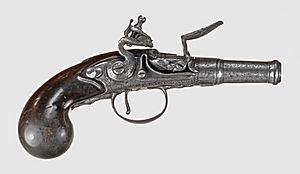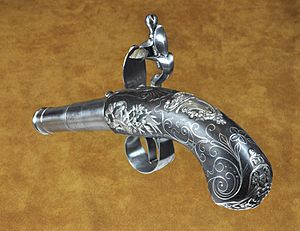Queen Anne pistol facts for kids
Queen Anne pistols are a special kind of flintlock pistol. They are also called turn-off pistols because their barrel could be unscrewed. This allowed them to be loaded from the front, right into the chamber.
These pistols became popular in England when Queen Anne was ruling (from 1702 to 1714). That's how they got their name! A cool thing about these pistols is that they were often made quite small. This made them easy to carry and hide. Some larger carbines (a type of rifle) were also made with this design.
Contents
What Makes Them Special?
Queen Anne pistols have three main features that make them unique.
Turn-Off Barrel
First, they have a barrel that unscrews. This barrel often had a wider, "cannon-like" end. To load the pistol, you would unscrew the barrel. This gave you access to the chamber inside.
Special Body Design
Second, the main body of the pistol (where the bullet and powder go) and the lock-plate were made as one piece. The lock-plate holds the firing parts. This design is sometimes called a boxlock because the firing parts are partly hidden. However, it's still a bit like a traditional sidelock design where parts are on the side.
Frizzen Spring
Third, the frizzen spring was placed at the back of the frizzen, not the front. The frizzen is a part that creates a spark to fire the pistol. This special placement made it easier to remove the barrel for loading.
How They Were Loaded
Queen Anne pistols were usually rifled. This means the inside of the barrel had spiral grooves. These grooves helped the bullet spin, making it fly straighter.
To load one:
- You would use a special tool, like a small wrench, to unscrew the barrel.
- Then, you would pour gunpowder into the chamber.
- Next, a bullet was placed into a special cup-like seat at the end of the chamber.
- Finally, the barrel was screwed back on. The end of the barrel was slightly wider to fit around the bullet.
- When the pistol was fired, the bullet would expand slightly. This made it fit tightly into the rifling grooves, creating a good seal.
Why They Were Popular
The design of Queen Anne pistols was perfect for making small, easy-to-hide firearms. People sometimes called them overcoat pistols, toby pistols, or muff pistols. This shows how easily they could be carried in a coat pocket or even a hand warmer.
These pistols were also known for being very fancy. They often had beautiful decorations and showed great skill in how they were made.






